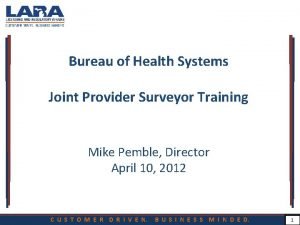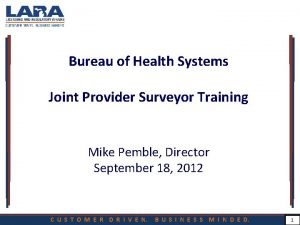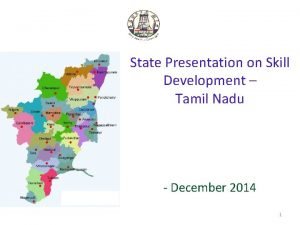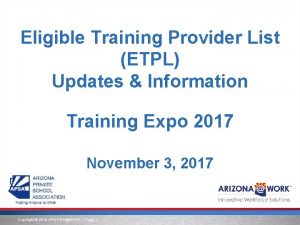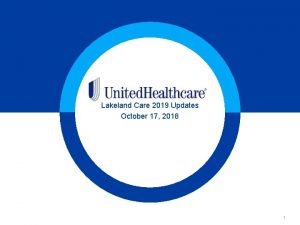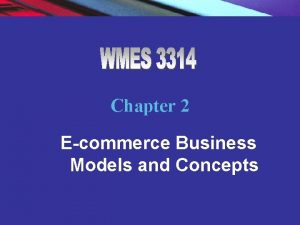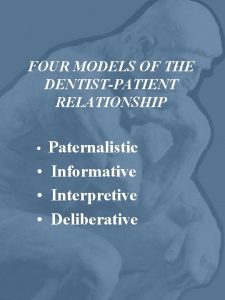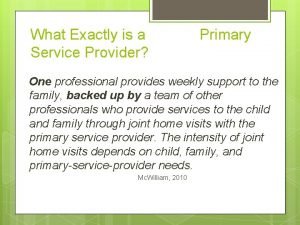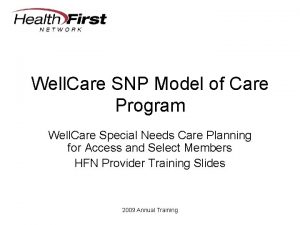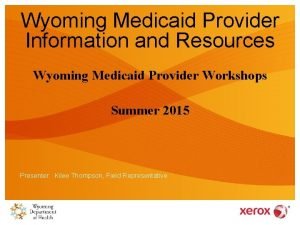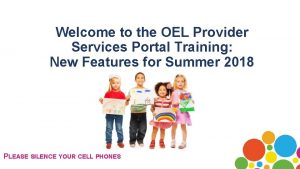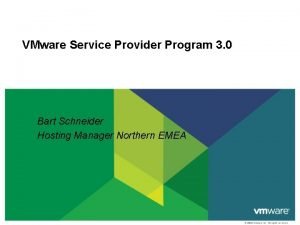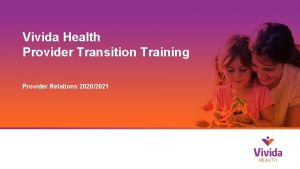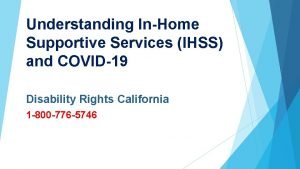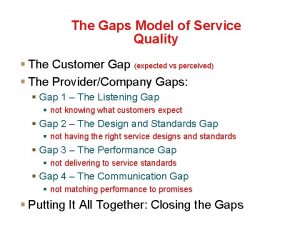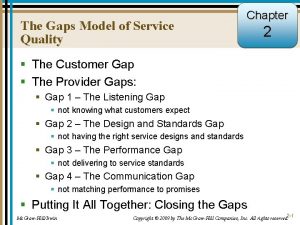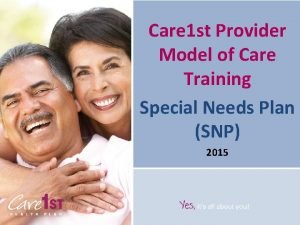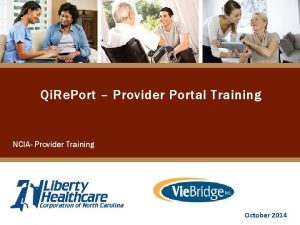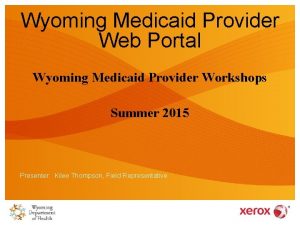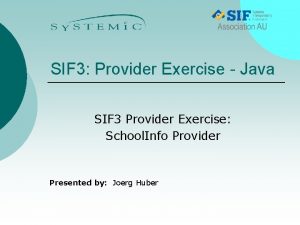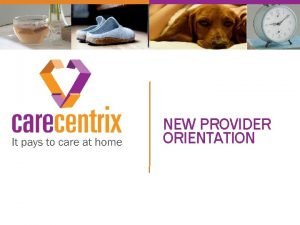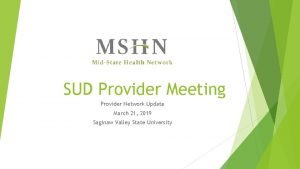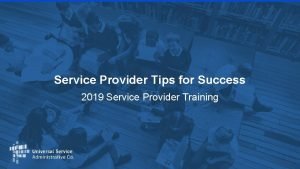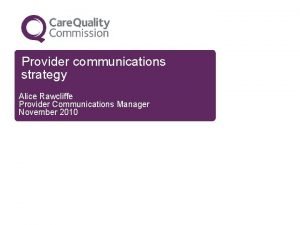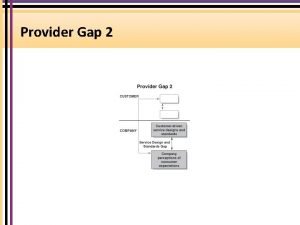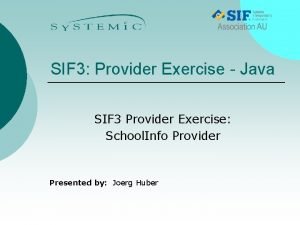Care 1 st Provider Model of Care Training
























- Slides: 24

Care 1 st Provider Model of Care Training Special Needs Plan (SNP) 2017

SNP Model of Care(MOC) The Medicare Act of 2003 established a Medicare Advantage coordinated care plan that is designed to provide targeted care to individuals with special needs. Care 1 st MOC is designed to ensure the provision and coordination of specialized services that meet the needs of the dual eligible beneficiaries. 2

Elements of the Care 1 st SNP Model of Care(MOC) • • Description of the Special Needs population Care coordination Provider network MOC quality measurement and performance Improvement 3

Description of the Overall SNP Population • Care 1 st provides services to Special Needs Plan members in Los Angeles, Orange, San Bernardino, San Diego and Santa Clara counties • Care 1 st performs a population assessment of these members in order to build a Model Of Care that will properly serve their needs. 4

Description of the Overall SNP Population (continued) Some of the factors we identify include but are not limited to the following: 1. Age 2. Gender 3. Ethnicity 4. Incidence and prevalence of major diseases and chronic conditions 5. Language barriers and health literacy 6. Significant barriers to health care services associated with cultural beliefs or socioeconomic status 5

Most Vulnerable Beneficiaries • Sub-population of special needs population at highest risk of poor health outcomes • Identification based on multiple hospital admissions, high pharmacy utilization, high cost, or combination of medical, psychosocial, cognitive and functional challenges • Identify how various demographic factors combine to adversely affect health status of these members 6

Most Vulnerable Beneficiaries Continued • Identify and develop special services to meet the needs of the most vulnerable members • Care 1 st has developed relationships with a number of community partners such as Multipurpose Senior Service Programs (MSSP), Alzheimer's Association, Areas Agency on Aging( AAA) and In Home Support Services (IHSS) in order to provide specialized resources and maximize care coordination 7

Staff Structure and Care Coordination Roles • Care 1 st staff is organized and aligned to support essential care coordination roles • The staff is either contracted or employed and performs the following functions: Ø Administrative (Enrollment, eligibility verification, claims processing and administrative oversight) Ø Clinical Functions (Case managers, social workers, pharmacists, behavioral health providers and clinical oversight) 8

Staff Structure and Care Coordination Roles Continued • Care 1 st has a contingency plan to avoid disruption in care when existing staff is absent • All staff are trained on the MOC initially upon hire and annually 9

Health Risk Assessment(HRA) Tool • Care 1 st has a standardized HRA tool • HRA assesses the medical, cognitive, functional, psychosocial and mental health of each beneficiary • The HRA may be completed face-to-face, telephonic, or paper-based by mail • Initial HRA is completed within 90 days of enrollment an at least annually there after 10

Health Risk Assessment(HRA) Tool Continued • Member is reassessed if needed when there is a change in health status • Answers to the HRA are used to: – develop and/or update the members’ Individualized Care Plan (ICP) – stratify member into risk categories for care coordination • Member is provided with a copy of the ICP and encouraged to visit the PCP • Provider is given a copy of the ICP and the answers to the HRA. 11

Individualized Care Plan(ICP) • An initial ICP is developed upon completion of the HRA • Essential components of the ICP includes: – Goal and objectives, – Healthcare preferences – Specific services tailored to the member as needed – Identification of goals met/not met 12

Individualized Care Plan(ICP) Continued • ICP is reviewed and updated at least annually or when a member health status changes • ICP updates and modifications are communicated to member/or caregivers and providers, and other stakeholders as necessary • ICP is maintained and stored to assure access by all care providers • Records of the ICP are stored per HIPAA and professional standards 13

Interdisciplinary Care Team (ICT) • ICT facilitates care management, assessment, care planning, authorization of services and care transitions. • Composition of ICT is dependent on the members medical and psycho social needs as determined by the HRA and ICP. It typically includes Case Managers, Social Workers, Pharmacists, Medical Directors and treating physicians • Members and caregivers are encouraged to participate 14

Interdisciplinary Care Team (ICT) Continued • The (ICTs) are aligned with the delegated delivery system. PCPs and specialty physicians are active participants • Each member of ICT has specific defined roles and responsibilities based on their expertise • Review and analyze available data to ensure improvement in the member’s health status 15

Interdisciplinary Care Team (ICT) Continued • Care 1 st has a communication system in place to facilitate information flow between members of the ICTs, members/care givers, physicians, such as: – Documentation in the care management system which is member centric – Regular telephonic communication with member/caregiver and providers – Written ICT meeting minutes – Documentation in the member’s ICP – Member data dashboard that includes utilization and pharmacy data that can be shared via portal or by fax 16

Care Transition Protocols 1. Care transition is a. Movement of a member from one care setting to another as the member’s health status changes 2. Care 1 st is committed to manage planned and unplanned transitions for our members as they move from one health care setting to the next. 3. Within 1 day of notification of an admission to a hospital, a copy of the most current ICP is faxed to the hospital 17

Care Transition Protocols Continued 4. Within 1 day of discharge from a hospital to a skilled nursing facility, the discharge orders/care plan are faxed to the skilled nursing facility 5. When the member is being transitioned to the usual setting of care ( typically the home), the Case Manager will discuss the discharge plan with the member and/or caregiver. This will be followed within 2 business days with a phone call to ensure the member is familiar with the appropriate self management tools and to assist with scheduling a follow up appointment with the Primary Care Physician 6. The Primary Care Physician will be notified by fax within 3 business days of all care transition episodes. 18

Provider Network • Care 1 st has specialized network of providers to meet the needs of its SNP members including but not limited to: – Internist, geriatricians, endocrinologists, cardiologist, oncologist, pulmonologist – General and subspecialty surgeons – Behavioral Health Providers – Ancillary health providers such as physical, speech and occupational therapists – Tertiary care physicians 19

Provider Network Continued • Care 1 st, through policies and procedures ensures that network providers: – Have active licenses and certification – Are part of the member’s ICT as needed – Incorporate relevant clinical information in member’s ICP – Follow transition of care protocols – Use clinical practice guidelines – Can request exception to clinical practice guidelines for members with complex healthcare needs – Receive MOC training initially on joining the network and annually thereafter • Care 1 st has policy and procedures to address network providers non-compliance with MOC training 20

Use of Clinical Practice Guidelines(CPGs) Care 1 st ensures use of clinical practice guidelines: – Requires all medical groups to use evidence-based nationally approved CPGs for making UM decisions – Approves all CPGs annually – Approved guidelines are communicated to the network via provider news letters and the provider website – Member education materials are reviewed annually to ensure consistency with approved CPGs 21

Use of Clinical Practice Guidelines(CPGs) Continued – Care 1 st has a process for management of exceptions to available CPGs when a member has complex healthcare needs by utilizing outside independent board certified physicians – Compliance with approved guidelines is monitored through: • An annual review of delegated group utilization decisions • The member appeals process • Review of patient medication profiles in the Medication Therapy Management(MTM) Program • HEDIS reporting 22

Care 1 st MOC Quality Measurement and Performance Improvement 1. Care 1 st has a Quality Improvement Plan ( QIP) that is specific to the MOC and designed to meet the health care needs of its members. 2. Care 1 st collects, analyses and evaluates various data sources in order to report on the MOC quality performance improvement. 3. Specific HEDIS health outcome measures are identified in order to measure the impact that the MOC has on the SNP members. 23

Care 1 st MOC Quality Measurement and Performance Improvement Continued 4. SNP member satisfaction surveys are utilized in order to asses overall satisfaction with the MOC 5. All health outcomes and satisfaction survey findings are utilized to modify the MOC QIP on an annual basis 6. The annual evaluation of the QIP is shared with providers and stakeholders via the Care 1 st website. 24
 Dcs provider training
Dcs provider training Opito central register
Opito central register Joint provider surveyor training michigan
Joint provider surveyor training michigan Joint provider surveyor training michigan
Joint provider surveyor training michigan Training provider-tnskill.tn.gov.in
Training provider-tnskill.tn.gov.in Etpl
Etpl Clearinghouse applicant initiated
Clearinghouse applicant initiated Lakeland care provider portal
Lakeland care provider portal Transaction broker business model example
Transaction broker business model example E-commerce business models and concepts
E-commerce business models and concepts Deliberative model of doctor-patient relationship
Deliberative model of doctor-patient relationship Primary service provider example
Primary service provider example Primary secondary tertiary care
Primary secondary tertiary care Snp model of care training
Snp model of care training Training is expensive without training it is more expensive
Training is expensive without training it is more expensive Perbedaan on the job training dan off the job training
Perbedaan on the job training dan off the job training Aggression replacement training facilitator training
Aggression replacement training facilitator training Sector and multiple nuclei model
Sector and multiple nuclei model Wyoming medicaid provider manual
Wyoming medicaid provider manual Elchc
Elchc Vmware service provider program
Vmware service provider program Po box 211290 eagan mn 55121
Po box 211290 eagan mn 55121 Ca time now
Ca time now Provider gaps
Provider gaps Service gaps model
Service gaps model


